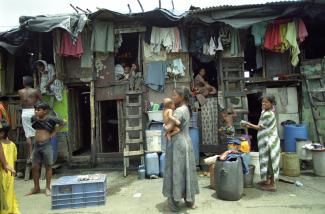Poverty
Many metrics

A whole range of measurement systems have been developed in recent years. The Global Policy Forum, an independent think tank, and the civil society organisation terre des hommes have now published a report looking at the most frequently discussed approaches. They all have in common that they question the conventional indicators of progress – especially gross domestic product (GDP).
GDP is criticised for including activities that promote not growth, but merely the maintenance of productive capital. Public goods and many non-material assets such as health, environmental quality, childcare and voluntary service are not considered appropriately. Furthermore, GDP does not reflect inequalities in society.
Most alternative measurement systems attempt to take in account some of these aspects, the report says. One of the main issues since the emergence of the environmental movement in the 1970s is the value of intact ecosystems and the services they render. The UN has developed various methods of calculating “Green GDP”; examples include the System of Integrated Environmental and Economic Accounting (SEEA) and the Millennium Ecosystem Assessment (MEA).
The ecological footprint concept developed in 1990 has been widely applied in recent years. It measures the area of biologically productive land and sea needed to supply all the energy and resources that a given human population consumes. The concept of planetary boundaries, first mooted in 1972, has also been revisited in recent years. It identifies nine processes – including climate change, freshwater use and ocean acidification – that risk irreversible damage to the global ecosystem if continued beyond certain limits.
Income poverty as an indicator
Income poverty is the main statistical yardstick applied in development policy so far. The UN defined the poverty threshold as the purchasing power of one dollar a day per capita income, and later raised it to $1,25. Today, this metric is widely criticised because it fails to take account of the complexity of poverty. In 1990, the United Nations Development Programme (UNDP) launched the Human Development Index (HDI) and the Human Poverty Index (HPI, 1996) as a set of metrics for poverty based on indicators such as life expectancy, education and health. In 2010, the HDI and the HPI were supplanted by the Multidimensional Poverty Index (MPI).
The latest trend identified in the report involves initiatives seeking to define development and wellbeing in a broader sense by considering at least three dimensions of sustainability: economic, social and environmental. As examples, the authors cite the sustainability indicators of the UN Commission on Sustainable Development (CSD) and the OECD’s Better Life Index, which addresses eleven dimensions of wellbeing, including income, safety and life satisfaction.
The report does not find a universal method of measurement. There are pros and cons to all of the approaches. However, the authors do identify a number of universal criteria for measuring social wellbeing and sustainable development. They believe that any new approach needs to:
- overcome the weakness of the present GDP approach;
- address at least three dimensions of sustainability, i.e. social, economic and political;
- indicate inequalities and disadvantaged social groups;
- take account of the needs of not only present but also future generations;
- avoid over-economisation of issues such as nature or climate, aplying non-economic variables as yardsticks as well;
- take account of global contexts;
- be designed in a way that allows for political conclusions; and
- consider not just quantifiable values but also qualitative ones.
The authors believe that measuring systems that meet these requirements could serve policymaking as policies could be verified and policy makers held to account.
Sabine Balk
Link:
Report: Gut leben global (only in German):
https://www.globalpolicy.org/images/pdfs/GPFEurope/GPF-Gut_leben_global-web.pdf










